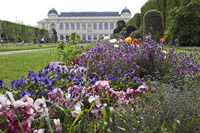Summary | Excerpt | Reviews | Beyond the Book | Read-Alikes | Genres & Themes | Author Bio

Critics' Opinion:
Readers' Opinion:
First Published:
Sep 2009, 304 pages
Paperback:
May 2010, 320 pages
 Book Reviewed by:
Book Reviewed by:
Sarah Sacha Dollacker
Buy This Book
This article relates to The Coral Thief
 The Jardin
des Plantes in Paris was the epicenter of naturalist research in the early 1800s and is currently one of the world's foremost botanical gardens. Built in 1626,
it was planted in 1635 as a medicinal herb garden for the King of France. It
was opened to the public in 1640, greatly expanded under superintendent G.L.L
Buffon, and eventually developed into a center of scientific study. Georges
Cuvier, Jean-Baptiste Lamarck, the Jussieu brothers, and other prominent scientists
of the time were all associated with the Jardin des Plantes and conducted research
there. During the early 19th century, the facility supported expeditions to
different parts of the world to acquire large numbers of plants and animals
that had previously been unknown to the Western world.
The Jardin
des Plantes in Paris was the epicenter of naturalist research in the early 1800s and is currently one of the world's foremost botanical gardens. Built in 1626,
it was planted in 1635 as a medicinal herb garden for the King of France. It
was opened to the public in 1640, greatly expanded under superintendent G.L.L
Buffon, and eventually developed into a center of scientific study. Georges
Cuvier, Jean-Baptiste Lamarck, the Jussieu brothers, and other prominent scientists
of the time were all associated with the Jardin des Plantes and conducted research
there. During the early 19th century, the facility supported expeditions to
different parts of the world to acquire large numbers of plants and animals
that had previously been unknown to the Western world.
The Jardin des Plantes' transition from medicinal garden to botanical garden
is typical of the historical development of botanical gardens. The first modern botanic
gardens* were the physic gardens in 16th - 17th century Italy, and the first
of these was the garden created at the University of Pisa in 1543 by Luca Ghini.
These gardens were designed to facilitate the academic study of medicinal plants,
and by the late 16th century, similar gardens were being planted in universities
and apothecaries across Europe.
During the age of exploration, as European nations began to discover other cultures
and ecosystems, these gardens underwent a great change. As new species were
discovered in disparate parts of the world and brought back to Europe, the
botanical gardens began to cultivate and conduct research on these new found
plant species. Some countries - like England and France - founded botanical
gardens in their colonies. The French Pamplemousse Botanic Garden (now the Sir Seewoosagur Ramgoolam Botanic Garden) was founded
in Mauritius in 1735 and the British Calcutta Botanic Garden was established
in 1787 in India. These gardens - both in the colonies and Europe - received
and cultivated commercial crops such as cloves, breadfruit, cinchona, palm oil
and chocolate. During this time, Para rubber was introduced to Singapore,
teak and tea to India, and breadfruit, pepper and star fruit to the Caribbean.
Though these gardens seemed to function like the traditional gardens, they were
mainly in place as commercial ventures, rather than academic pursuits.
By the 19th and 20th century botanical gardens were mainly developed for pleasure purposes rather than for
academic or commercial reasons. There are still a few botanical gardens - the
Missouri Botanical Garden, for example - that maintain a scientific mission,
but these are often limited to labeling plant collections and seed distribution,
rather than cultivation and research.
 Today, The Jardin des Plantes covers
about 11 acres, and houses the Grande Galerie de l'Évolution, and
the Minerology, Paleontology, and Entymology museums of the Muséum
national d'histoire naturelle.
Today, The Jardin des Plantes covers
about 11 acres, and houses the Grande Galerie de l'Évolution, and
the Minerology, Paleontology, and Entymology museums of the Muséum
national d'histoire naturelle.
Top: The Mexican Hothouse built (1834-36) by Rohault de Fleury
Bottom: The entrance to the Grande Galerie de l'Évolution
*Gardens dedicated at least in part to the display or use of plants are known to have existed in ancient civilizations including Rome, Mexico and China. For example, in 2800 BCE, it is recorded that the Chinese Emperor Shen Nung sent collectors to distant parts in search of plants with economic and medicinal value. It is thought that the development of modern botanical gardens was influenced by the Spanish conquest of Mesoamerica and the invaders' realization that the Aztecs knew more about medicinal plants than did Europe.
Filed under Places, Cultures & Identities
![]() This "beyond the book article" relates to The Coral Thief. It originally ran in January 2010 and has been updated for the
May 2010 paperback edition.
Go to magazine.
This "beyond the book article" relates to The Coral Thief. It originally ran in January 2010 and has been updated for the
May 2010 paperback edition.
Go to magazine.





The House on Biscayne Bay
by Chanel Cleeton
As death stalks a gothic mansion in Miami, the lives of two women intertwine as the past and present collide.

The Flower Sisters
by Michelle Collins Anderson
From the new Fannie Flagg of the Ozarks, a richly-woven story of family, forgiveness, and reinvention.

The Funeral Cryer by Wenyan Lu
Debut novelist Wenyan Lu brings us this witty yet profound story about one woman's midlife reawakening in contemporary rural China.
Your guide toexceptional books
BookBrowse seeks out and recommends the best in contemporary fiction and nonfiction—books that not only engage and entertain but also deepen our understanding of ourselves and the world around us.